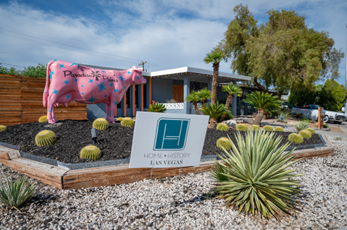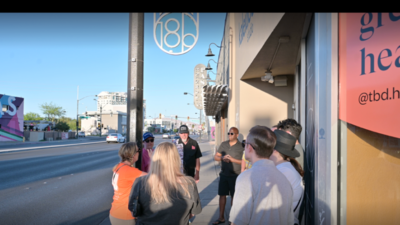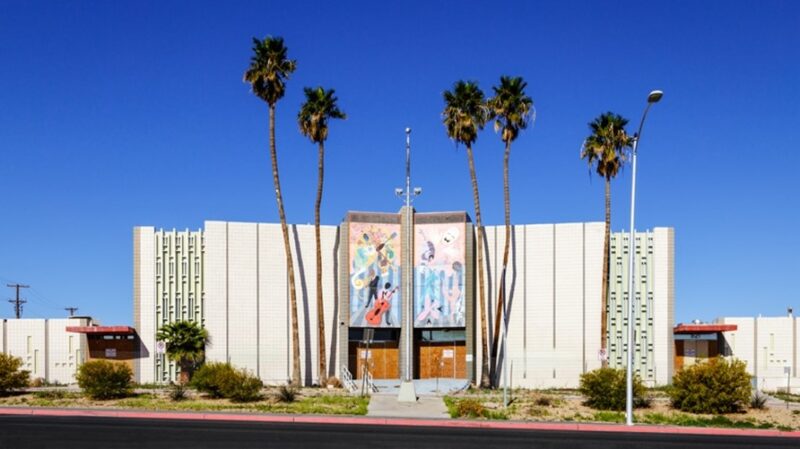Preserving Las Vegas: The Role of Community Engagement and Adaptive Reuse in Las Vegas Home + History
23 October 2023 – Paige Figanbaum
The tourist perception of Las Vegas is often limited to its iconic neon lights, or recently, the Knights hockey team winning the Stanley Cup championship. While The Strip has played a significant role in shaping the city, it tends to overshadow Las Vegas’ rich history and community. The Home + History events of Nevada Preservation Foundation (NPF) help provide a fuller portrait of the city’s past by promoting sustainable building practices through adaptive reuse in Las Vegas’ historic neighborhoods and buildings. In working with NPF on these events, I have collaborated with local community members to demonstrate the importance of historic preservation in thinking about local history, sustainability, and adaptive reuse within Las Vegas’s historic neighborhoods.
When I was hired as NPF’s Program Manager and Research Lead in January 2023, I began directing graduate students in writing/developing tours about Las Vegas’s historic neighborhoods. The Las Vegas Home + History was the largest event organized by NPF to date. It featured more than 45 tours dedicated to educating about–and advocating for–preservation, urban sustainability, and community development in Las Vegas. While some tours were carried over from previous events, the NPF board requested additional tours focusing on historic neighborhoods including Huntridge, Beverly Green, and 18b (an arts district). These previous tours developed by local community members played a vital role in community engagement and helped expand my understanding of sustainability issues within the built environment.

A photograph of Paradise Palms’ historic neighborhood’s distinctive pink cow during Home + History, April 27-30, 2023. Photo Credit: AO Creatives LV photo by Angie Ortaliza. Copyright Nevada Preservation Foundation, All rights reserved, 2023.
The involvement of community members–especially business owners in the Las Vegas Art District–was fundamental to the success of Home + History. In collaboration with business owners, I designed a tour entitled “Hops and History” focusing on the adaptive reuse of buildings within the “18b” area, so named because of its form in the city’s original 1905 grid encompassing 18 blocks or 18b.
The tour highlighted the business owners’ roles in promoting the efficacy of adaptive reuse by exploring historic buildings, such as the Arts Factory, once an air conditioning business now transformed into an artist’s space. The business owners collaborated with me to infuse their voices and experiences into cultivating 18b as a living, working, and playing community that is a place for local Las Vegans. Today, the Arts District uses several historic buildings to house a multitude of restaurants, bars, live performance venues, street art, art galleries, and vintage stores. 18b is becoming one of the most popular up-and-coming areas of Las Vegas.

A photograph of Hops and History tour located at historic neighborhood 18b during Home + History, April 27-30, 2023. Photo Credit: AO Creatives LV photo by Angie Ortaliza. Copyright Nevada Preservation Foundation, All rights reserved 2023.
Crafting the Hops and History tour posed challenges from varying perspectives among the supportive businesses and organizations in 18b. To address this, I engaged with business owners featured in the tour, capturing their lived experiences while respecting the district’s intricate dynamics. Challenges emerged regarding historical context and language in the tour’s content. During the review process, 18b business owners urged for more discussion of community building in the tour and highlighted the importance of recognizing the efforts of the Las Vegas Arts District Neighborhood Association. Additional challenges arose in deciding which historical aspects to include or exclude, such as balancing 18b’s historical significance as a retail district during the post-World War II era of rapid growth and emphasizing the current influence of the Arts District. With the involvement of local business owners, Hops and History successfully demonstrated how adaptive reuse reduces urban sprawl and lessens environmental impact in the desert.
Despite these successes, challenges have emerged in advocating for historic preservation. In past efforts, NPF and invested local community members championed the adaptive reuse of the Reed Whipple Cultural Center. Originally a place of worship for The Church of Jesus Christ of Latter-Day Saints (1963), the building was sold to the city in 1970 and has served as a cultural center hosting a gallery, classrooms, offices, and the Rainbow Company Youth Theater. However, in recent years the Reed Whipple Center has been threatened with demolition because of a proposed light-rail project. With the joint effort of local organizations, politicians, and museums, the Reed Whipple Cultural Center continues to stand, thanks in part to the Neon Museum’s acquisition of the center for adaptive reuse. Yet, as of December 2022, contracts have been signed to demolish this significant architectural structure. The struggles of the Reed Whipple Cultural Center demonstrate the urgency of historic preservation amid an ever-evolving city.

Reed Whipple Cultural Center. Photo Credit: Nevada Preservation Foundation, Las Vegas Uncommon Modern: Exhibition Catalog (Nevada Preservation Foundation: Las Vegas, 2019).
Historic preservation has not only preserved Las Vegas’ history but also underscored the city’s evolving dynamics and changing landscapes. Since 2011, Las Vegas’ population of Kānaka Maoli and other Pacific Islanders in the larger Clark County population has grown over 40 percent; they now represent the greatest number of newcomers in any country outside of Hawaii. Las Vegas is drawing a large influx of Hawaiians due to the real estate crisis, with Hawaii having the highest cost of living out of all fifty states. As Cee Cullen, a Kānaka Maoli, recently explained: “We got priced out of paradise, but all these traditions, all our language, it’s part of our identity.” This has been readily apparent during Maui wildfires, with developers responding with attempts to buy Hawaiian real estate after the devastation. Although Hawaiians are leaving their homes, they are finding creative ways to caretake their culture in the desert by teaching hula, making leis, and performing home blessings for new arrivals. Hawaiians’ creative ways of preserving their culture, including the founding of the Las Vegas Hawaiian Civic Club, demonstrates the multifaceted ways historic preservation can foster and honor community in an ever-changing city.
Las Vegas continues its urban redevelopment practices, especially with the introduction of professional sports teams and their large facilities. These historic neighborhoods and buildings face total erasure without the collaborative efforts of organizations like NPF. Community engagement takes many forms that can establish enduring relationships beyond the Las Vegas Home + History event. Collaborating with NPF and crafting tours, I grasped the profound impact of community building through NPF’s Home + History. It not only preserves Las Vegas’ dynamic history but also instills sustainable practices for conserving the desert landscape for established residents and newcomers alike.
~ Paige Figanbaum is a sixth-year Ph.D. candidate at the University of Nevada–Las Vegas. She has eight years of public history experience, including management of museum collections, National Register of Historic Places work, and teaching. Twitter: @P_Figs



